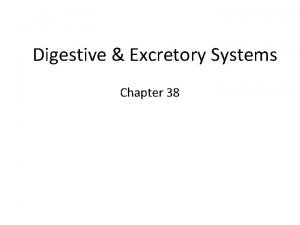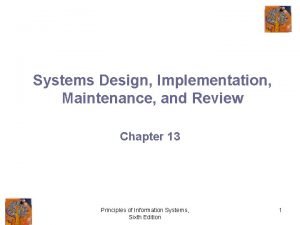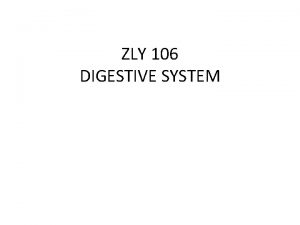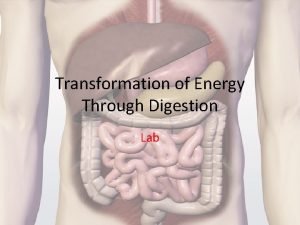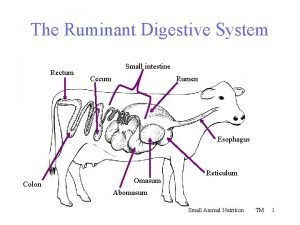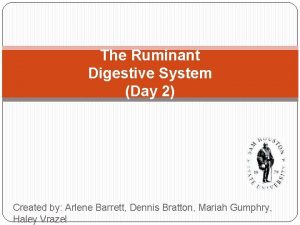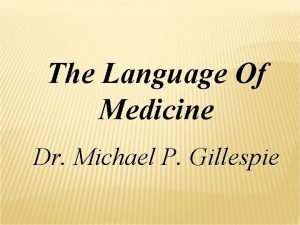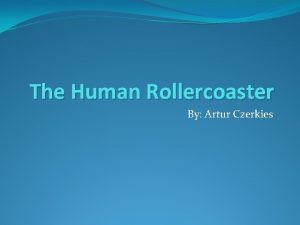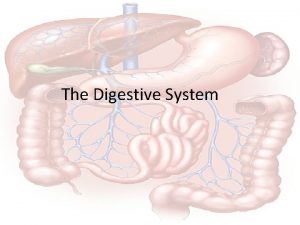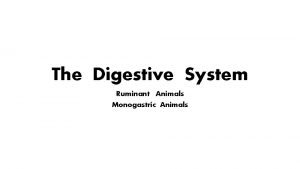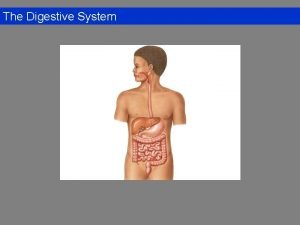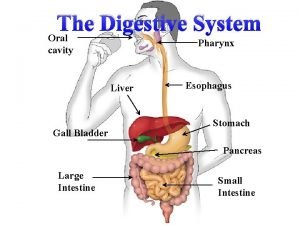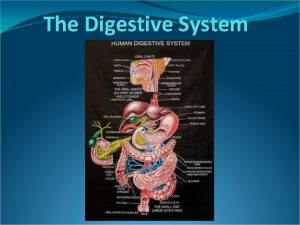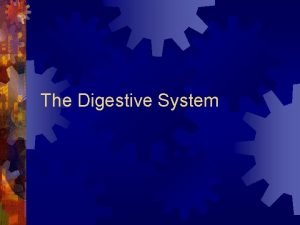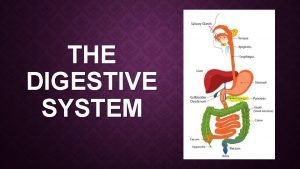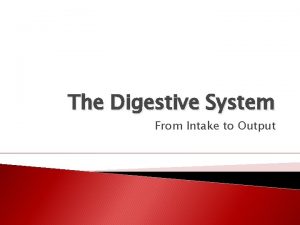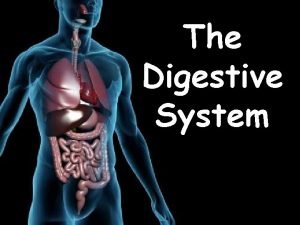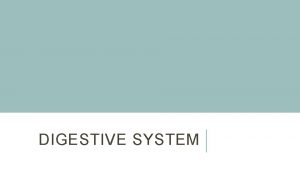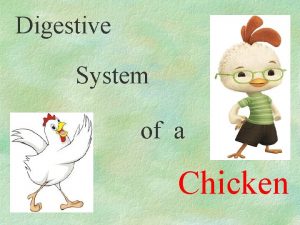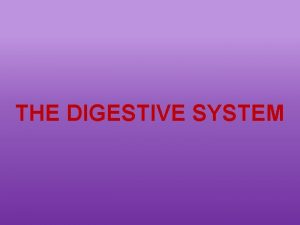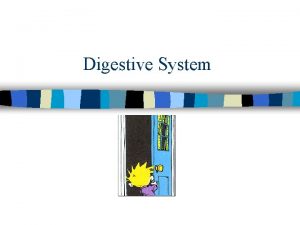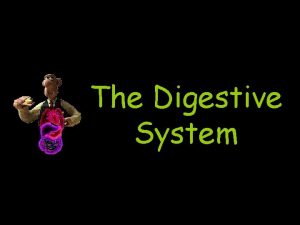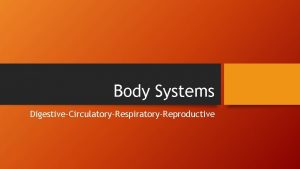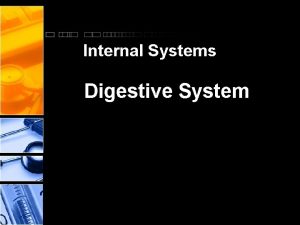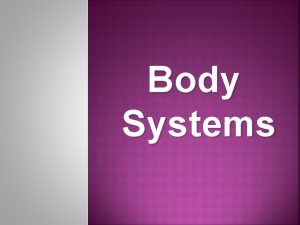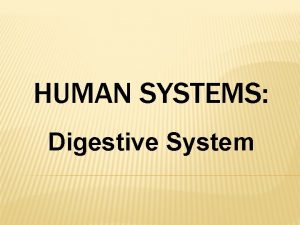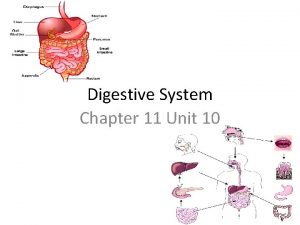The Digestive System Maintenance Systems Unit 5 The

























- Slides: 25

The Digestive System Maintenance Systems Unit 5

The Basic Functions of the Digestive System • Ingestion-taking nutrients into the body, i. e. , eating • Digestion-the mechanical and chemical breakdown of food into a usable form • Absorption-the movement of molecules through the mucosal lining of the stomach and small intestine, and into the blood • Excretion-the removal of solid waste from the body

The Digestive Organs • • Mouth Pharynx Esophagus Stomach Small Intestines Large Intestines Rectum Anus


Mouth • • Mechanical digestion-chewing Chemical digestion-digestion of carbohydrates

Pharynx • Also called the throat • A passageway for food, liquids, and air

Esophagus • Muscular tube located behind the trachea • About 10 inches long • Transports food from the pharynx to the stomach

Stomach • J-shaped pouch located below the diaphragm • Chemical digestion of protein occurs in the stomach due to gastric juice secretion • Mechanical digestion occurs in the stomach due to maceration (churning) • Three regions: fundus, body, pyloris


Small Intestines • • Chemical digestion of nutrients and absorption of nutrients is completed in the small intestines Three divisions of the small intestines: – – – Duodenum – first portion of the small intestine where the majority of chemical digestion occurs. Jejunum – middle portion of the small intestine where the majority of absorption of nutrients occurs. Ileum – final portion of the small intestine where absorption occurs.


Large Intestines • The large intestines are the last part of the digestive system. • Absorption of water, vitamins, electrolytes, production of vitamin K, and formation of feces occurs in the large intestines


Rectum • The last portion of the large intestine which functions in temporary storage of solid wastes before excretion

Anus • The final portion of the rectum where solid waste is excreted from the body


Diseases and Careers of the Digestive System

Colon Cancer • Most of the cancers of the large intestine are believed to have developed from polyps (benign tumors). • Cancer of the colon and rectum, also called colorectal cancer can invade and damage adjacent tissues and organs. • Symptoms include fatigue, weakness, shortness of breath, change in bowel habits including diarrhea or constipation, red or dark blood in stool, weight loss, abdominal pain, cramps, or bloating. • Surgery is the most common treatment for colon cancer.

Chron’s Disease • Chron’s disease is an ongoing disorder that causes inflammation of the digestive tract. • The disease can affect any area of the GI tract, from the mouth to the anus, but it most commonly affects the lower part of the small intestine, the ileum. • The swelling extends deep into the lining of the affected organ. • The swelling can cause pain and can make the intestines empty frequently, resulting in diarrhea. • Chron’s disease may be caused by an abnormally functioning immune system. • Treatment includes prescription medications, nutritional supplements, surgery, or a combination of these. • There is no cure.

Chron’s Disease

Celiac Disease • Celiac disease is a digestive disease that damages the small intestine and interferes with absorption of nutrients from food. • People who have celiac disease cannot tolerate a protein called gluten, found in wheat, rye, and barley. • When people with celiac disease eat foods or use products that contain gluten, their immune system responds by damaging the small intestine. • Celiac disease is an autoimmune disease that is genetic. • The most common symptoms include pain in the digestive system or other parts of the body. • The only know treatment is a gluten-free diet.

Appendicitis • Appendicitis, inflammation of the appendix, is the most common surgical disease. • It results from the obstruction of the opening to the appendix by a mass, stricture or infection. • Symptoms of appendicitis include generalized abdominal pain, pain localized in the lower right abdomen, nausea, vomiting, possibly fever, and an elevated white blood cell count. • Treatment involves the removal of the appendix and antibiotics.

Inguinal Hernia • Inguinal hernias occur when a part of the intestine protrudes through a weak point or tear in the abdominal wall. • This protrusion creates a bulge which can be painful. • Some inguinal hernias occur at birth when the abdominal lining does not close properly. • Other inguinal hernias occur later in life when muscles weaken or deteriorate. • The most common treatment is surgery.

Careers • Dentist – diagnose, prevent, and treat problems with teeth or mouth tissue. They remove decay, fill cavities, straighten or repair teeth. May also perform corrective surgery on gums and bones that support the teeth. • Dental Assistant – work chair-side for dentists and perform patient care, office and lab duties. They also hand instruments and materials to the dentist and use suction or other devices. Also sterilize and disinfect instruments, prepare trays of instruments, and instruct patients in oral care.

• Dental Hygienist – clean teeth, teach proper oral care; examine patient teeth and gums; take x-rays; may prepare diagnostic tests for dentists to interpret; may also work chair-side with the dentist. • Dietitian- plan food and nutrition programs; prevent and treat illnesses by promoting healthy eating habits; may also conduct research. • Central Service Technician- responsible for cleaning, processing, sterilizing, storing and distributing medical supplies needed in patient care, especially during surgery.
 Digestive respiratory and circulatory system
Digestive respiratory and circulatory system Nervous system and digestive system
Nervous system and digestive system Questions on digestive system
Questions on digestive system System maintenance and review
System maintenance and review Bentley systems asset maintenance
Bentley systems asset maintenance Unit 10, unit 10 review tests, unit 10 general test
Unit 10, unit 10 review tests, unit 10 general test Da pam 750-35
Da pam 750-35 In this unit you learned to talk about home maintenance
In this unit you learned to talk about home maintenance Sheep digestive system
Sheep digestive system Monogastric system
Monogastric system Digestive system energy transformation
Digestive system energy transformation Conclusion of digestive system
Conclusion of digestive system Ruminant digestion
Ruminant digestion Ruminant stomach
Ruminant stomach øhuman digestive system
øhuman digestive system Digestive system roller coaster project
Digestive system roller coaster project Human digestive system facts
Human digestive system facts 4 chambers of the ruminant stomach
4 chambers of the ruminant stomach Digestive system histology
Digestive system histology Function of liver and pancreas in digestion
Function of liver and pancreas in digestion Digestive system intro
Digestive system intro Double sheets of peritoneal membrane
Double sheets of peritoneal membrane Pepto bysmol
Pepto bysmol Output of the digestive system
Output of the digestive system Intestine
Intestine Cardiac sphincter
Cardiac sphincter


